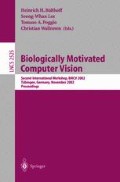Abstract
Computational vision models that attempt to account for perception of depth from motion usually compute the optical flow field first. From the optical flow the ego-motion parameter are then estimated, if they are not already known from a motor reference. Finally the depth can be determined. The better the ego-motion parameters are known by extra-retinal information to be restricted to certain values before the optical flow is estimated, the more reliable is a depth-from-motion algorithm. We show here, that optical flow induced by translational motion mixed with specific rotational components can be dynamically mapped onto a head-centric frame such that it is invariant under these rotations. As a result, the spatial optical flow dimension are reduced from two to one, like purely translational flow. An earlier introduced optical flow algorithm that operates in close approximation of existing brain functionality gains with this preprocessing a much wider range of applications in which the motion of the observer is not restricted to pure translations.
Access this chapter
Tax calculation will be finalised at checkout
Purchases are for personal use only
Preview
Unable to display preview. Download preview PDF.
References
Marr, D.: Vision. W.H. Freeman and Company, New York, 2000.
Nakayama, K., Loomis J.M.: Optical velocity patterns, velocity-sensitive neurons, and space perception: a hypothesis. Perception 3 (1974) 63–80.
. Longuet-Higgins H.C., Prazdny K.: The interpretation of a moving retinal image. Proc. R. Soc. Lond B Biol. Sci. 208 (1980) 385–397.
Gibson, J.J. The perception of the visual world. Houghton Mifflin, Boston, 1950.
Poggio G.F., Torre V., Koch C.: Computational vision and regularization theory. Nature, 317 (1985) 314–319.
Wörgötter, F., Cozzi, A., Gerdes V.: A parallel noise-robust algorithm to recover depth information from radial flow fields. Neural Comput. 11 (1999) 381–416.
Horn, B.K.P.: Robot Vision. The MIT Press, Boston, 1986.
Barron, J.L., Fleet, D.J., Beauchemin, S.S.: Performance of optical flow techniques. International Journal of Computer Vision, 12 (1994) 43–77.
Andersen R.A., Essick G.K., Siegel R.M.: Encoding of spatial location by posterior parietal neurons. Science. 230(1985) 456–458.
Zipser D., Andersen R.A.: Related Articles A back-propagation programmed network that simulates response properties of a subset of posterior parietal neurons. Nature. 331 (1988) 679–684.
Marsh D.: Applied Geometry for Computer Graphics and CAD. Springer-Verlag, Berlin Heidelberg New York, 1999.
Schwartz, E.: Spatial mapping in the primate sensory projection: analytic structure and relevance to perception.: Biol. Cybern. 25 (1977) 181–194.
Wagner H.: Flight performance and visual control of flight of the free-flying housefly (Musca domestica l.). I. Organization of the flight motor. Phil. Trans. R. Soc. Lond., B312 (186) 527–551.
Wallman J., Letelier J.-C.: Eye movments, head movments and gaze stabilization in birds. In Zeigler H.P., Bishop H.J. (Eds) Vision brain and behavior in birds. MIT Press. Cambridge, 1993.
Author information
Authors and Affiliations
Editor information
Editors and Affiliations
Rights and permissions
Copyright information
© 2002 Springer-Verlag Berlin Heidelberg
About this paper
Cite this paper
Dahlem, M.A., Wörgötter, F. (2002). Rotation-Invariant Optical Flow by Gaze-Depended Retino-Cortical Mapping. In: Bülthoff, H.H., Wallraven, C., Lee, SW., Poggio, T.A. (eds) Biologically Motivated Computer Vision. BMCV 2002. Lecture Notes in Computer Science, vol 2525. Springer, Berlin, Heidelberg. https://doi.org/10.1007/3-540-36181-2_14
Download citation
DOI: https://doi.org/10.1007/3-540-36181-2_14
Published:
Publisher Name: Springer, Berlin, Heidelberg
Print ISBN: 978-3-540-00174-4
Online ISBN: 978-3-540-36181-7
eBook Packages: Springer Book Archive

